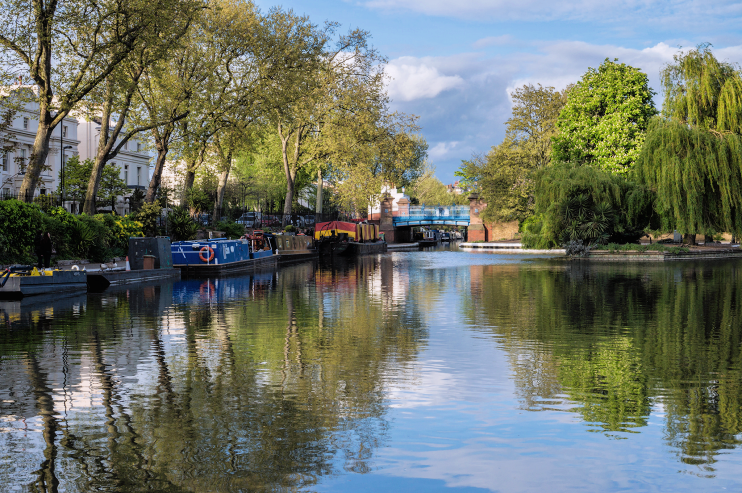Little Venice
Little Venice, Westminster
A canal intersection and its pretty – if flawed – vicinity on the border of Paddington and Maida Vale

A pool was created here in the 1810s at the meeting point of the Regent’s Canal and the Paddington arm of the Grand Junction (now Grand Union) Canal, and was originally known as Paddington Broadwater. A small island with willows and wildfowl makes a kind of roundabout at the junction, which was always intended as a spot for pleasure boats. The islet is nowadays known as Browning’s Island, after the poet Robert Browning, who lived nearby.
The neighbouring area was built up in a piecemeal but harmonious fashion from the second quarter of the 19th century, especially with terraces and pairs of three-storey stuccoed houses.
In her 1934 detective novel Death of a Ghost, Margery Allingham gave the name ‘Little Venice’ to a house overlooking the canal. The name caught on with estate agents after the Second World War and is still much used for the pricey properties in the locality.
The locality bears little actual resemblance to Venice and the incongruous 1960s flats on Warwick Crescent mar its charm but the jolly houseboats moored along the canalsides lend Little Venice a picturesque appearance.
Artists’ studios on the east side of the pool were demolished and replaced by a small park, named Rembrandt Gardens in 1975 to commemorate the 700th anniversary of the founding of the city of Amsterdam, the ‘Venice of the North’. Public walkways were opened on both sides of the pool around this time.
Most of Little Venice was part of the Maida Vale estate belonging to the Church Commissioners, who offered the freeholds for sale in the 1980s, when a number of houses were bought by property companies and converted into flats.

The Puppet Theatre began staging marionette performances in a converted barge in 1982. The vessel seats 55 and its red and yellow awning is visible in the photograph at the top of this article.* During the summer, the floating theatre makes a tour of the Thames but it’s usually in Little Venice from October to July.
Organised by the Inland Waterways Association, the Canalway Cavalcade takes place over the early May bank holiday weekend. This colourful festival has been held annually (except in 2020) at Little Venice since 1983.
More than half the adult population of Little Venice is qualified to degree level or higher. The ward has relatively high numbers of Arab and Kurdish residents. Also, a significant proportion of Little Venice’s inhabitants come from Australia, New Zealand, North America and continental western Europe – including 161 from Italy (but Venetians are not separately enumerated in the census data).
Short-story writer Katherine Mansfield, playwright Christopher Fry, novelist Elizabeth Jane Howard and Icelandic chanteuse Björk are among those who have had homes in Little Venice.
